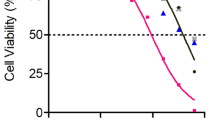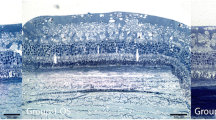Abstract
The 21-aminosteroids or lazaroids are a novel series of compounds being developed for the acute treatment of traumatic or ischemic injury of the nervous system. These compounds were specifically designed to localize within cell membranes and inhibit lipid peroxidation reactions. In this study, 21-aminosteroid U75412E was injected into the vitreous body of rabbit eyes to evaluate its suitability for intraocular injection and its toxicity on intraocular tissues. Doses ranged from 20 Μg to 200 Μg. Retinal toxicity was determined through light and transmission electron microscopy and electroretinography. No retinal toxicity was noted in doses of 30 Μg and below.
Similar content being viewed by others
References
Anderson DK, Means ED. Lipid peroxidation in spinal cord; FeCl2 induction and protection with antioxidants. Neurochem Pathol 1983; 1: 43–264.
Braughler JM. Lipid peroxidation-induced inhibition of γ- aminobutyric acid uptake in rat brain synaptosomes: protection by glucocorticoids. J Neurochem 1985; 44: 1282–1288.
Braughler JM, Burton PS, Chase RL, et al. Novel membrane localized iron chelators as inhibitors of iron-dependent lipid peroxidation. Biochem Pharmacol 1988; 37: 3853–3860.
Braughler JM, Chase RL, Neff GL, et al. A new 21-aminosteroid antioxidant lacking glucocorticoid activity stimulates adrenocorticotropin secretion and blocks arachidonic acid release from mouse pituitary tumor (AtT-20) cells. J Pharmacol Exp Ther 1988; 244: 423–427.
Braughler JM, Hall ED. Current application of ‘high-dose’ steroid therapy for CNS injury; a pharmacological perspective. J Neurosurg 1985; 62: 806–810.
Braughler JM, Hall ED, Jacobsen EJ, et al. The 21-aminosteroids; potent inhibitors of lipid peroxidation for the treatment of central nervous system trauma and ischemia. Drugs of the Future 1989; 14: 143–152.
Braughler JM, Hall ED, Means ED, et al. Evaluation of an intensive methylprednisolone sodium succinate dosing regimen in experimental spinal cord injury. J Neurosurg 1987; 67: 102–105.
Braughler JM, Lainer MJ. The effects of large doses of methylprednisolone on neurologic recovery and survival in a Mongolian gerbil following three hours of unilateral carotid occlusion. Cent Nerv Syst Trauma 1986; 3: 153–162.
Braughler JM, Pregenzer JF, Chase RL, et al. Novel 21- amino steroids as potent inhibitors of iron-dependent lipid peroxidation. J Biol Chem 1987; 262: 10438–10440.
Freeman BA, Crapo JD. Free radicals and tissue injury. Lab Invest 1982; 47: 412–426.
Hall ED, Braughler JM. Acute effects of intravenous glucocorticoid pretreatment on thein vitro peroxidation of cat spinal cord tissue. Exp Neurol 1981; 73: 321–324.
Hall ED, Braughler JM. Glucocorticoid mechanisms in acute spinal cord injury: a review and therapeutic rationale. Surg Neurol 1982; 18: 320–327.
Hall ED, McCall JM, Chase RL, et al. A nonglucocorticoid steroid analog of methylprednisolone duplicates its highdose pharmacology in models of central nervous system trauma and neuronal membrane damage. J Pharmacol Exp Ther 1987; 242: 137–142.
Hall ED, Travis MA. Inhibition of arachidonic acid-induced vasogenic brain edema by the non-glucocorticoid 21-aminosteroid U74006F. Brain Res 1988; 451: 350–352.
Hall ED, Travis MA, Braughler JM. Pharmacological interventions in CNS ischemia and trauma; studies with high dose methylprednisolone. In: Vincent JL, editor. Update in intensive care and emergency medicine. Springer-Verlag, Berlin, pp 341–346, 1986.
Halliwell B, Gutteridge JMC. Oxygen toxicity, oxygen radicals, transition metals and disease. Biochem J 1984; 219: 1–14.
Ingold KU, Webb AC, Witter D, et al. Vitamin E remains the major lipid-soluble, chain-breaking antioxidant in human plasma even in individuals suffering severe vitamin E deficiency. Arch Biochem Biophys 1987; 259: 224–225.
Jenkins RR. Free radical chemistry: relationship to exercise. Sports Med 1988; 5: 156–170.
Kontos HA. Oxygen radicals in cerebral vascular injury. Circ Res 1985; 57: 508–516.
Kurihara M. Role of monoamines in experimental spinal cord injury in rats; relationship between Na+-K+-ATPase and lipid peroxidation. J Neurosurg 1985; 62: 743–749.
Machlin LJ, Bendich A. Free radical tissue damage: protective role of antioxidant nutrients. FASEB J 1987; 1: 441–445.
McCall JM, Hall ED, Braughler JM. A new class of 21- aminosteroids which are useful for stroke and trauma. In: Capildeo R, editor. Steroids in diseases of the central nervous system. John Wiley & Sons, Ltd., Chichester, UK, pp 69–80, 1989
McCay PB. Vitamin E; Interactions with free radicals and ascorbate. Annu Rev Nutr 1985; 5: 323–340.
McCord JM. Oxygen-derived free radicals in postischemic tissue injury. N Engl J Med 1985; 312: 159–163.
McCord JM, Roy RS. The pathology of Superoxide: roles in inflammation and ischemia. Can J Physiol Pharmacol 1982; 60: 1346–1352.
Natale JE, Schott RJ, Hall ED, et al. Effect of the aminosteroid U74006F after cardiopulmonary arrest in dogs. Stroke 1988; 19: 1371–1378.
Szabo ME, Droy-Lefaix MT, Doly M, et al. Ischemia and reperfusion-induced histologie changes in the rat retina. Invest Ophthalmol Vis Sci 1991; 32: 1471–1478.
Weiss SJ. Oxygen, ischemia and inflammation. Acta Physiol Scand 1986; 548 (suppl): 9–37.
Williams RN, Paterson CA, Eakins KE, et al. Ascorbic acid inhibits the activity of polymorphonuclear leukocytes in inflamed ocular tissues. Exp Eye Res 1984; 39: 261–265.
Author information
Authors and Affiliations
Rights and permissions
About this article
Cite this article
Cruz, S.A., KaraÇorlu, M. & Peyman, G.A. Retinal toxicity of intravitreal lazaroid (21-aminosteroid U75412E). Int Ophthalmol 16, 153–157 (1992). https://doi.org/10.1007/BF00916434
Accepted:
Issue Date:
DOI: https://doi.org/10.1007/BF00916434




